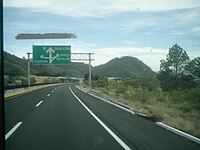
Federal Highway 15 is Mexico 15 International Highway or Mexico-Nogales Highway, is a primary north–south highway, and is a free part of the federal highways corridors of Mexico. The highway begins in the north at the Mexico–United States border at the Nogales Port of Entry in Nogales, Sonora, and terminates to the south in Mexico City.
Federal Highway 1D is a tolled part of the Mexico Federal Highways, paralleling Fed. 1. There are two segments, one in the state of Baja California and another in the state of Baja California Sur.

Carretera Federal 85D is the designation for toll highways (autopistas) paralleling Federal Highway 85. Two roads are designated Highway 85D, one from Nuevo Laredo, Tamaulipas, to Monterrey, Nuevo León, known as Autopista Monterrey–Nuevo Laredo, and the other from Pachuca, Hidalgo, to Mexico City, known as Autopista Pachuca–Ciudad de México. Both toll routes run parallel to their free alternative, Federal Highway 85. Highway 85D has wider lanes offers a more direct route and is continuously being repaired and repaved unlike the free route.
The Arco Norte, designated and signed as Federal Highway M40D, is a toll road in Mexico. It serves as a bypass around Greater Mexico City and currently links the Mexico-Puebla toll road on the east with the Mexico-Guadalajara toll road on the west.
Federal Highway 180D is the toll highways paralleling Highway 180 in seven separate segments of highway. Three are in Veracruz:, the Libramiento de Cardel, the highway from Cardel to Veracruz, and the Nuevo Teapa-Cosoleacaque highway. Four segments exist beyond Veracruz: one between Agua Dulce and Cárdenas, Tabasco, facilitating a connection from the city of Coatzacoalcos in Veracruz; a bypass of Villahermosa; one connecting Champotón to Campeche City, Campeche; and another connecting the cities of Mérida, Yucatán, and Cancún, Quintana Roo. An additional segment, connecting the latter highway to Playa del Carmen, is officially part of Highway 180D, but is signed as Highway 305D.
Federal Highway 70D is the designation for toll highways paralleling Mexican Federal Highway 70.

Federal Highway 117D is the designation for two toll highways in eastern Mexico.
Federal Highway I-20D, known as the Libramiento de Irapuato, is a toll highway that serves as a bypass of the city of Irapuato, Guanajuato. The road is operated by HOATSA, which charges 68 pesos per vehicle to travel the full course of the highway. The road opened on March 15, 2011, at a construction cost of 900 million pesos.
Federal Highway 200D is the toll highways paralleling Fed. 200, and has two separate improved segments of designated roadway. Fed200D in Colima funnels traffic from Manzanillo toward Fed. 110 to the city of Colima; the segment in Guerrero serves as a bypass of Tecpan.
Federal Highway 90D is a toll highway between Zapotlanejo and Guadalajara, Jalisco. The road is operated by Red de Carreteras de Occidente, which charges cars 70 pesos to travel Highway 90D. RCO operates the segments of Mexican Federal Highway 15D and Mexican Federal Highway 80D that connect into the road.
Federal Highway 80D is the designation for toll highways paralleling Mexican Federal Highway 80. There are two such roads, one between Zapotlanejo and Lagos de Moreno, Jalisco and the other connecting Lagos de Moreno to San Luis Potosí City.
Federal Highway 140D is a toll (quota) part of the federal highways corridors that connects Puebla City to Xalapa.
Federal Highway 2D is a part of the federal highways corridors, and is the designation for toll highways paralleling Mexican Federal Highway 2. Seven road segments are designated Highway 2D, all but one in the state of Baja California, providing a toll highway stretching from Tijuana in the west to around Mexicali in the east; one in Sonora, between Santa Ana and Altar; and another between the cities of Matamoros and Reynosa in Tamaulipas.
Federal Highway 40D is the designation for toll highways paralleling Mexican Federal Highway 40. Highway 40D connects Mazatlán, Sinaloa to Reynosa, Tamaulipas. It forms most of the highway corridor between Mazatlán and Matamoros, Tamaulipas, one of 14 major highway corridors in the country.
Federal Highway 45D is a toll part of the paralleling Fed. 45. Eleven separate tolled segments exist of Fed. 45D between Querétaro City and Villa Ahumada in Chihuahua, between Chihuahua City and Ciudad Juárez.
Federal Highway 190D is the tolled Federal Highway that parallels Federal Highway 190. Highways with the 190D signage are in the states of Oaxaca and Chiapas.
The Autopista Tepic–San Blas is a toll highway in the Mexican state of Nayarit. The 32.4-kilometre (20.1 mi) road was constructed and is operated by Red de Carreteras de Occidente, which charge cars 49 pesos or 69 pesos to travel the full length of the road.
Federal Highway 57D (Fed. 57D) is a tolled (cuota) part of the federal highways corridor of the paralleling Fed. 57. Eight separate tolled segments exist of Fed. 57D between Mexico City and Allende, Coahuila; a ninth is part-federal and part-state.
The Macrolibramiento Sur de Guadalajara, designated and signed as Federal Highway GUA 10D, is a toll road in Mexico. It serves as a bypass around Greater Guadalajara and currently links the Guadalajara–Tepic toll road on the west with the Guadalajara–Lagos de Moreno toll road to the east. The highway opened in its entirety in November 2017; it was formally inaugurated on January 8, 2018, by President Enrique Peña Nieto. As of 2018, the toll for the 111-kilometre (69 mi) stretch of highway is 299 pesos.
Sinaloa State Route 1D is a toll state route that replaces Mexican Federal Highway 15D from Culiacan to Las Brisas. It was built from 1998 to 2001 when Mexico was beginning to build toll roads as a faster alternative to the poorly-maintained and older free roads. It is the only toll road alternate for free road Fed. 15 in the northern part of the state.




